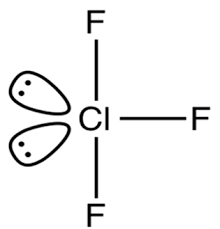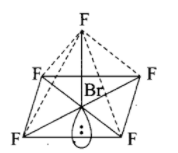
Given below is the table showing shapes of some molecules having lone pairs of electrons. Fill up the blanks left in it.
Molecule Type bp lp Shape Example \[A{{B}_{2}}{{E}_{2}}\] 2 P Bent \[{{H}_{2}}O\] \[A{{B}_{3}}{{E}_{2}}\] 3 2 Q \[Cl{{F}_{3}}\] \[A{{B}_{5}}{{E}_{{}}}\] 5 R S \[Br{{F}_{5}}\] \[A{{B}_{4}}{{E}_{2}}\] 4 2 T U
(A) P-2, Q - Square pyramidal, R - 2, S - T-shaped, T - Square planar, U - \[{{H}_{2}}{{O}_{2}}\]
(B) P-4, Q - T-shaped, R - 5, S - square planar, T - Square pyramidal, U - \[S{{O}_{3}}\]
(C) P-2, Q - T-shaped, R - 1, S - square pyramidal, T - Square planar, U - \[Xe{{F}_{4}}\]
(D) P-3, Q - Square planar, R - 2, S - T-shaped, T - Square pyramidal, U - \[BrC{{l}_{3}}\]
| Molecule Type | bp | lp | Shape | Example |
| \[A{{B}_{2}}{{E}_{2}}\] | 2 | P | Bent | \[{{H}_{2}}O\] |
| \[A{{B}_{3}}{{E}_{2}}\] | 3 | 2 | Q | \[Cl{{F}_{3}}\] |
| \[A{{B}_{5}}{{E}_{{}}}\] | 5 | R | S | \[Br{{F}_{5}}\] |
| \[A{{B}_{4}}{{E}_{2}}\] | 4 | 2 | T | U |
Answer
179.7k+ views
Hint: Understand the description of molecule type and find out which letter represents the bond pair and which one represents the number of lone pairs. Draw the structure of the compound to find out the shape as well as to give an example.
Complete step by step solution:
We will first define the molecule type and find out the letter representing the number of lone pairs(lp).
In the molecule type,
-Central atom-A
-Neighbouring atoms-B
-lone pair-E
- For molecule type \[BrC{{l}_{3}}\], the number of lone pairs is 2. Hence the value of P is 2.
-We will now try to find out the shape of the molecule type \[A{{B}_{3}}{{E}_{2}}\]i.e. draw the structure of \[Cl{{F}_{3}}\].

-From the above structure, we can conclude that the molecule is T-shaped. Hence the answer for Q is T-shaped.
-For the molecule type \[A{{B}_{5}}{{E}_{{}}}\]the number of lone pairs is 1. Let us draw the structure of molecule type \[A{{B}_{5}}{{E}_{{}}}\].
Structure of \[Br{{F}_{5}}\] (Molecule type - \[A{{B}_{5}}{{E}_{{}}}\]):

From the above diagram, it is clear that the shape is square pyramidal. Hence the value of R is 1 and the answer for S is square pyramidal.
-Let us draw the structure of molecule type \[A{{B}_{4}}{{E}_{2}}\]:
From the above structure, we can conclude that the shape of the molecule is square planar.
Example: \[Xe{{F}_{4}}\]
Hence the answer for T is square planar and U is \[Xe{{F}_{4}}\].
Therefore, the correct answer is option (C).
Note: While drawing the structures for different molecule types, always highlight the lone pairs to easily calculate the number of lone pairs. Remember that the shape and geometry of a molecule are not always the same. When lone pairs are present, the shape of the molecule is different from the geometry of the molecule.
Complete step by step solution:
We will first define the molecule type and find out the letter representing the number of lone pairs(lp).
In the molecule type,
-Central atom-A
-Neighbouring atoms-B
-lone pair-E
- For molecule type \[BrC{{l}_{3}}\], the number of lone pairs is 2. Hence the value of P is 2.
-We will now try to find out the shape of the molecule type \[A{{B}_{3}}{{E}_{2}}\]i.e. draw the structure of \[Cl{{F}_{3}}\].

-From the above structure, we can conclude that the molecule is T-shaped. Hence the answer for Q is T-shaped.
-For the molecule type \[A{{B}_{5}}{{E}_{{}}}\]the number of lone pairs is 1. Let us draw the structure of molecule type \[A{{B}_{5}}{{E}_{{}}}\].
Structure of \[Br{{F}_{5}}\] (Molecule type - \[A{{B}_{5}}{{E}_{{}}}\]):

From the above diagram, it is clear that the shape is square pyramidal. Hence the value of R is 1 and the answer for S is square pyramidal.
-Let us draw the structure of molecule type \[A{{B}_{4}}{{E}_{2}}\]:

From the above structure, we can conclude that the shape of the molecule is square planar.
Example: \[Xe{{F}_{4}}\]
Hence the answer for T is square planar and U is \[Xe{{F}_{4}}\].
Therefore, the correct answer is option (C).
Note: While drawing the structures for different molecule types, always highlight the lone pairs to easily calculate the number of lone pairs. Remember that the shape and geometry of a molecule are not always the same. When lone pairs are present, the shape of the molecule is different from the geometry of the molecule.
Recently Updated Pages
Hess Law of Constant Heat Summation: Definition, Formula & Applications

JEE Atomic Structure and Chemical Bonding important Concepts and Tips

JEE Amino Acids and Peptides Important Concepts and Tips for Exam Preparation

JEE Electricity and Magnetism Important Concepts and Tips for Exam Preparation

Chemical Properties of Hydrogen - Important Concepts for JEE Exam Preparation

JEE Energetics Important Concepts and Tips for Exam Preparation

Trending doubts
JEE Main 2025 Session 2: Application Form (Out), Exam Dates (Released), Eligibility, & More

JEE Main 2025: Derivation of Equation of Trajectory in Physics

Displacement-Time Graph and Velocity-Time Graph for JEE

Atomic Structure - Electrons, Protons, Neutrons and Atomic Models

Learn About Angle Of Deviation In Prism: JEE Main Physics 2025

What is Hybridisation in Chemistry?

Other Pages
JEE Advanced Marks vs Ranks 2025: Understanding Category-wise Qualifying Marks and Previous Year Cut-offs

NCERT Solutions For Class 11 Chemistry Chapter 1 Some Basic Concepts of Chemistry in Hindi - 2025-26

JEE Main 2025: Conversion of Galvanometer Into Ammeter And Voltmeter in Physics

Electron Gain Enthalpy and Electron Affinity for JEE

JEE Advanced Weightage 2025 Chapter-Wise for Physics, Maths and Chemistry

NCERT Solutions For Class 11 Chemistry Chapter 7 Redox Reaction - 2025-26




